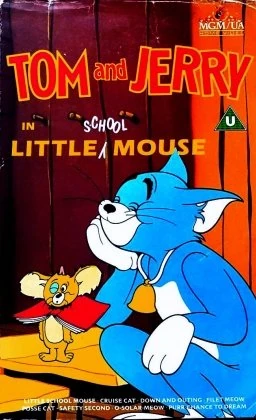
Neapolitan Mouse is one of those films that showed how William Hanna and Joseph Barbera were able to depart from the average Tom and Jerry formula while still staying true to what makes these cartoons so popular.
This short film starts with your typical Tom and Jerry chase. Tom chases Jerry off a boat and into Italy. Their slapstick antics wake up an Italian mouse named Topo. At first Topo is annoyed by the noises. However, he soon recognizes Tom and Jerry from seeing their cartoons. He is a big fan of their cartoons and decides to show them around his home country. However, a group of bully dogs try to ruin their tour.
This is a very charming cartoon. The filmmakers make the best use of the Italian setting. The background art is simply lovely to look at and really helps give this short a different feel from your average Tom and Jerry short. The supporting characters are also a lot of fun. Topo is a delightful character who adds a lot of heart to the short. I love these tough guys with a heart of gold characters and this one is a delight. I also love the fun moment where he recognizes Tom and Jerry from their cartoons. I like to picture cartoon characters as working actors just like the ones in live action films. This is one of the rare times a Tom and Jerry film has one of these moments and it is quite fun. The dogs have a fun design and make for great antagonists. If I had one complaint about this cartoon, it is that it never made me laugh out loud. The gags aren't bad here, they are just the type to make you smile rather than really laugh.
The credited animators on this film are Ed Barge, Irven Spence, Ray Patterson and Kenneth Muse. The credited background artist is John Didrik Johnsen. This one of the rare Tom and Jerry shorts he gets a credit on. For the most part he worked on the cartoons Tex Avery and Dick Lundy were directing for MGM at this time. A character is seen watching this cartoon on TV in the feature film, Starsky & Hutch (2004). The 2002 video game, Tom and Jerry in War of the Whiskers features a level called Ciao Meow, which is based off this short. The mobile game Tom and Jerry: Chase features Topo as a playable character. This cartoon is available on the DVD set, Tom and Jerry: Spotlight Collection Vol. 3.
The song Topo sings is the Italian romantic ballad Maria Marì. This song was composed in 1889 with music by Eduardo Di Capua and lyrics by Vincenzo Russo. Below is Luciano Pavarotti's recording of this song from his 1979 album, O Sole Mio - Favorite Neapolitan Songs as well as Dean Martin's 1947 swing version.











